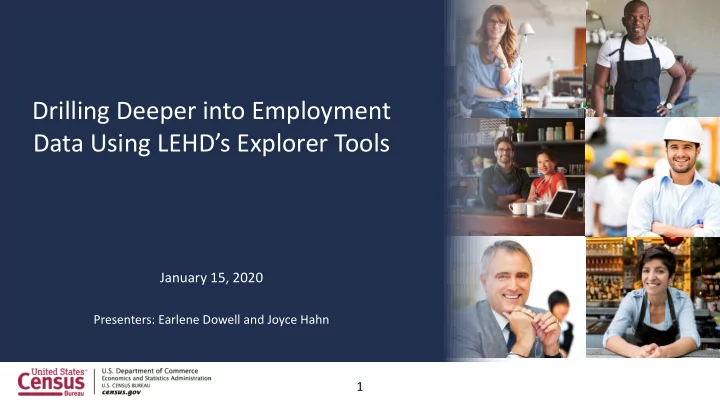

Drilling Deeper into Employment Data Using LEHD’s Explorer Tools January 15, 2020 Presenters: Earlene Dowell and Joyce Hahn 1
Disclaimer • Any opinions and conclusions expressed herein are those of the authors and do not necessarily represent the views of the U.S. Census Bureau. All results have been reviewed to ensure that no confidential information is disclosed. • Additionally, these opinions and conclusions are not representative of other data products or programs within the Census Bureau. 2
What are LEHD and LED? The LEHD Program at Census 3
Local Employment Dynamics: Public Use Data Products Job-to-Job Flows (J2J) Accessed The Quarterly Workforce Indicators through the J2J (QWI) Accessed through the QWI Job-to-Job Flows Flows Explorer Explorer (J2J) • Employment • Traces worker • Traces worker • Job Creation, Job Destruction, Hires, movement movement Separations, Turnover through through • By industry, county, CBSA, state, industries, industries, Workforce Investment Area (WIA) and geographic labor geographic labor worker characteristics markets, and markets, and OnTheMap/LEHD Origin-Destination Employment to/from to/from employment Statistics (LODES) Accessed through OnTheMap employment and OnTheMap for Emergency Management Post-Secondary Employment • Employment at the Census block level by Outcomes (PSEO) Accessed where workers live and work through the PSEO Explorer Popular uses - local economic • • New set of statistics on the development, business site selection, and earnings and employment emergency planning outcomes of graduates of post- secondary institutions in the United States, 4
5
LED Extraction Tool https://ledextract.ces.census.gov/static/data.html https://www.youtube.com/watch?v=AhFi59Fb zlw 6
QWI Explorer 32 Quarterly Workforce Indicators Flexible Pivot Table and Map/Chart interface Data on detailed interactions between firms and workers include employment, employment Analyze/report by firm change (individual and firm), and earnings characteristics: NAICS Analyze/report by worker classification (sector, 3, 4), firm demographics: age, earnings, age, and firm size race, ethnicity, educational Quarterly data very current attainment, and sex (9-12 months old) National and 50 states available (plus DC) 7
Average Monthly Earnings by Age 8
National Yearly Earnings 9
America Counts: Impact of Tech Boom on Housing 10
OnTheMap, LODES, and Labor Demand Shock 11
Amazon Effect 12
LODES/OnTheMap Update • LODES for 2016 and 2017 were released at the end of August – Both in raw data and OnTheMap • Additional releases: – Backfilled Wyoming data for 2014 and 2015 – Updated to TIGER 2018 (only affects the operation of OnTheMap and the geography crosswalk provided with LODES data) • Other key points: – Data for Alaska and South Dakota are not available in 2017 – Jobs for federal workers are not available in 2016 and 2017 – The default Job Type of OnTheMap was changed to “Private Primary Jobs” 13
OnTheMap for Emergency Management Hurricanes, Floods, Winter Storms Disaster Areas Wildfires New Public Data Service for Demographic & Emergency Preparedness & Economic Data Response • Comprehensive Reports • Real-time Data Updates • Easy-to-use & Interoperable • Historical Event Archive • Flexible Analyses & Visualizations
Physical Vulnerabilities Social Decennial ACS Economical LODES
https://onthemap.ces.census.gov/em/
J2J Explorer 40 Measures of Worker Reallocation Six Visualization Modules with a flexible dashboard interface Export reports to Excel or CSV Trace worker movements through Analyze/report by origin and industries, geographic labor markets, and to/from employment destination firm characteristics: Analyze/report by origin and NAICS Sector, firm age, and firm size destination geographies: Analyze/report by worker demographics: age, earnings, race, national and state-level ethnicity, educational attainment, and tabulations sex Data updated every quarter 17
Start with the Guided Entry 18
Where are New Hires to Memphis’s Transportation & Warehousing Sector Coming from? 19
Does the Origin Industry Vary by Origin MSA? Memphis 20
Does the Origin Industry Vary by Origin MSA? Nashville-Davidson--Murfreesboro--Franklin 21
Does the Origin Industry Vary by Origin MSA? Not in metropolitan area, MS 22
Do Earnings Vary by Origin MSA? 23
How about by Origin Industry? 24
Were workers hired into Memphis’s Transportation and Warehousing Sector previously employed? 25
PSEO Explorer PSEO data provide earnings and employment outcomes for college and university graduates by degree level, degree major, and post- secondary institution. These statistics are generated by matching university transcript data with a national database of jobs, using state-of-the-art confidentiality protection mechanisms to protect the underlying data. Currently, PSEO data are available for the University of Texas System, higher education institutions in Colorado, the University of Michigan, and the University of Wisconsin, Madison. 26
How Much are UT Austin Graduates Earning? 1-, 5-, 10-Years Post-Graduation 27
Where are UT Austin Graduates Working? 1-Year Post-Graduation 28
Where are UT Austin Graduates Working? 5-Years Post-Graduation 29
Where are UT Austin Graduates Working? 10-Years Post-Graduation 30
Where are UT Austin Graduates Working? 10-Years Post-Graduation 31
Where are UT Austin Graduates Working? 10-Years Post-Graduation 32
Takeaways: Why Are LED Data Tools Important? • Accessibility • “Explorability” • Provide context • Visualizations lead to insight • Promote/market the data • Provide “value-add” for our state partners 33
To sum up: The Longitudinal Employer-Household Dynamics Program links existing business and jobs data to create new sources of local, detailed, labor market information using the following data tools: -- QWI -- OnTheMap -- J2J Explorer 34
Q & A and Thank You! Contact Us At: Joyce.Key.Hahn@census.gov 301-763-7935 Earlene.KP.Dowell@census.gov 301-763-9628 35
Recommend
More recommend